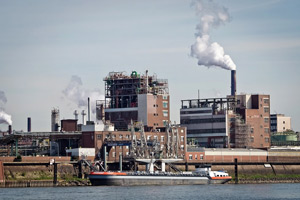Industrial Waste Water Treatment-- Improve Efficiency with Custom Water Treatment Equipments
Industrial Waste Water Treatment-- Improve Efficiency with Custom Water Treatment Equipments
Blog Article
Trick Methods in Industrial Waste Water Therapy Processes
The treatment of industrial wastewater is an essential aspect of environmental management, involving an array of techniques created to mitigate the impact of contaminants. Innovations in modern technologies such as membrane filtration and advanced oxidation processes use ingenious remedies for enhancing treatment efficacy.
Physical Treatment Approaches
Just how effectively can physical therapy approaches resolve the complexities of commercial wastewater? Physical treatment techniques play an essential duty in the initial phases of wastewater monitoring, concentrating largely on the removal of solids and huge particulates. Strategies such as filtering, flotation, and sedimentation are necessary for lowering the focus of suspended solids, thus enhancing the efficiency of succeeding therapy processes.
Sedimentation involves the gravitational settling of solids, permitting for the separation of heavier products from the wastewater. This method is specifically efficient in clarifying water prior to organic or chemical therapies.
Additionally, flotation protection methods, which make use of air bubbles to lift suspended solids to the surface area for removal, work in dealing with wastewater with high focus of fats, oils, and oils. In general, physical therapy techniques offer as a crucial primary step in the extensive monitoring of industrial wastewater, making certain that the lots on subsequent treatment phases is minimized and enhancing general therapy efficacy.
Chemical Treatment Strategies
While physical therapy approaches lay the groundwork for reliable wastewater administration, chemical treatment strategies are essential for addressing the a lot more complicated impurities typically found in commercial effluents. These methods utilize different chemical representatives to precipitate, counteract, or oxidize unsafe materials, making sure a more detailed removal of contaminants.
One typical strategy is coagulation and flocculation, where chemical coagulants such as aluminum sulfate or ferric chloride are contributed to advertise the aggregation of put on hold particles. This procedure boosts solid-liquid separation, minimizing turbidity and improving water top quality. Additionally, neutralization processes are utilized to change the pH of wastewater, using bases or acids to counteract acidic or alkaline streams, respectively.
Oxidation-reduction reactions play an important role in derogatory natural contaminants and virus. Chemical oxidants like chlorine, ozone, or hydrogen peroxide are used to break down complicated natural compounds, making them less dangerous or extra eco-friendly. In addition, progressed oxidation processes (AOPs) integrate numerous oxidation methods to boost contaminant elimination performance.
Biological Treatment Procedures
The performance of wastewater therapy is significantly enhanced by biological therapy processes, which harness the all-natural metabolic activities of bacteria to decay raw material and get rid of toxins. Industrial Waste Water Treatment. These procedures mainly involve aerobic and anaerobic food digestion, each customized for details kinds of wastewater
Cardio therapy processes use oxygen to support microbial growth, advertising the failure of organic pollutants right into co2 and water. Typical methods consist of turned on sludge systems, where oygenation containers help with the mixing of wastewater with microbes, and dripping filters, which motivate biofilm growth on media surface areas.
Conversely, anaerobic therapy processes occur in the lack of oxygen, using anaerobic germs to disintegrate raw material, causing biogas production, a renewable energy resource. Anaerobic digesters are usually utilized in industrial setups for this purpose, successfully decreasing the quantity of sludge while producing valuable biogas.
The selection of a biological therapy technique relies on wastewater attributes, treatment objectives, and regulative criteria. The combination of organic procedures in wastewater treatment not just enhances contaminant useful reference elimination efficiency yet also advertises sustainability by minimizing chemical use and sustaining resource recuperation.
Advanced Oxidation Processes

Common AOP methods consist of Fenton's photocatalysis, ozonation, and reagent. Fenton's reagent, a mix of hydrogen peroxide and ferrous iron, militarizes the formation of hydroxyl radicals, making it efficient for dealing with wastewater containing phenolic substances and various other stubborn substances.
AOPs provide numerous advantages, including lowered sludge manufacturing and the ability to deal with wastewater with high concentrations of natural pollutants. The application of AOPs calls for mindful factor to consider of functional specifications and cost-effectiveness, making sure that these innovative strategies are suitably incorporated right into existing wastewater therapy systems.
Membrane Layer Purification Technologies

Microfiltration works for removing suspended solids and germs, while ultrafiltration targets smaller sized natural particles and infections. Nanofiltration bridges the gap between ultrafiltration and reverse osmosis, effectively getting rid of divalent ions and organic substances. Reverse osmosis supplies the highest degree of filtration, made use of primarily for desalination and removing mono-valent ions.
Membrane modern technologies provide many benefits, including reduced energy usage compared to standard therapy methods, modular design for scalability, and the potential for water recovery and reuse. Nonetheless, challenges such as membrane fouling and the need for regular upkeep need to be resolved to ensure system efficacy. Generally, membrane filtering innovations represent a vital part of modern commercial wastewater therapy approaches, advertising sustainability and resource preservation in water monitoring.
Verdict
In final thought, commercial wastewater treatment uses a diverse variety of techniques, including physical, chemical, organic, and advanced techniques. Proceeded developments in these techniques will better enhance the effectiveness and performance of wastewater treatment processes in commercial setups.
The treatment of industrial wastewater is a critical element of ecological monitoring, entailing a variety of methods made to reduce the effect of impurities.How successfully can physical therapy methods deal with the complexities of commercial wastewater?Advanced oxidation processes (AOPs) represent an innovative strategy in commercial wastewater therapy, developed to properly degrade organic pollutants that are frequently resistant to conventional treatment techniques (Industrial Waste Water Treatment).In final thought, commercial wastewater therapy utilizes a diverse array of methods, consisting of physical, chemical, biological, and progressed approaches. Proceeded advancements in these methods will further improve the efficiency and efficiency of wastewater therapy procedures in industrial settings
Report this page